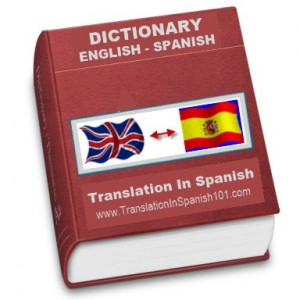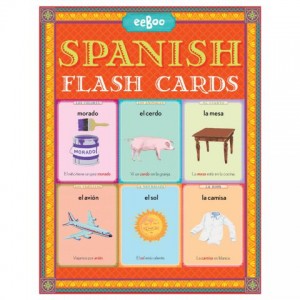Spanish is a widely spoken language. It is the second most spoken language by native speakers next to Mandarin. Over 400 million people worldwide speak Spanish as their native language while approximately 60 million people speak it as a second language. It is one of the six official languages of the United Nations and is designated as an official language by the European Union. It is spoken in over 22 countries. Considering all these, it can be said that there are many advantages in learning Spanish. The language is worth learning, and fortunately there are many ways to learn it easily and effectively. Learning with an expert Spanish language teacher or tutor can generally deliver better results but there’s no harm in trying to do it on your own, especially when you don’t have the money to spare to pay for the classes. Here are the best ways to learn Spanish on your own.
10. Using an English-Spanish Dictionary

An English-Spanish many not be the best option for learning Spanish but it can help. It is particularly useful in familiarizing with the words or building your Spanish vocabulary. The goal in having an English-Spanish dictionary is to have a connection with the Spanish language by being able to understand some words and to link these words with everyday use to establish familiarity. It would preferable to have a dictionary that includes clear pronunciation guides and examples of word usage. An English-Spanish dictionary app for smartphones or tablets can also serve the purpose.
9. Listening to Spanish Music or Using Spanish Learning Materials in Audio CDs

Listening to Spanish music can have the effect of improving your memory of Spanish words and phrases. It also helps in familiarizing with the phrasing, diction, enunciation, and other aspects of speaking Spanish. Of course, you can’t just play a CD and listen to the beautiful Spanish rhythm and vocals. It is also important to have a verbatim translation of the lyrics. Repetition also helps to better familiarize with the words and phrases. Songs can also serve as good references for Spanish expressions or idioms.
8. Reading News and Stories in Spanish

This works well if you are really interested in the news articles or if you have a news reading habit. Exposure to texts in Spanish can help train the brain in getting better acquainted with a foreign language. For many English speakers, it is not really very difficult to learn Spanish since the alphabets and pronunciation are mostly the same. There are also many English words that have been introduced to the English language. Reading news items in Spanish can be like a fill-in-the-blanks quiz that gradually helps broaden your Spanish vocabulary and familiarity with phrases and sentence structures.
7. Watching TV Shows or Movies in Spanish

Obviously, you shouldn’t be watching the dubbed telenovelas or movies. You want to preserve the original dialogs and simply see the translations at the bottom of the screen. This method of learning the language is particularly effective among those who become diehard fans the movies or TV shows. This can be best exemplified by many English speakers who have learned to read and speak Korean/Hangul to further connect with their Korean idols. It is important, however, to remember that subtitles are not exact translations of the dialogs. For the most part, translations are contextual so learning through shows and movies can be more of familiarizing the expressions, intonations, and idioms.
6. Spanish Language Learning Games and Cartoons

Interactive language learning games and cartoons work well with kids so there’s no reason for them not to work on adults. The amount of learning that can be obtained may be somewhat minimal but having such suffices for a good start. Those who are completely new to Spanish can make good use of language learning games and cartoons. They can even be fun for some.
5. Flash Cards and Picture Dictionaries

Flash cards and picture dictionaries are basic traditional tools for learning new languages. Over the years, they have proven to be effective in what they are supposed to do. They facilitate better the memorizing of words especially with the image association. Using them regularly can lead to gradual but continuous improvements in learning Spanish. Flash cards and picture dictionaries are quite easy to find. They are available in bookstores and can also be easily purchased online. You can even find free flash cards on the Internet that you can just download and print on your own.
4. Spanish Language Learning Software

Language learning software, especially those crafted by experts, are especially helpful in learning Spanish or any other language. Their interactivity and rich features can make memorizing easier. They can provide the combined benefits of flash cards, games, cartoons, audio language learning guides, and the reading of texts in Spanish. Some programs may even include quizzes or exercises. These software can be obtained from educational supplies stores or through the Internet. They can be quite expensive but the benefits they provide are definitely worth the price.
3. Online Spanish Leaning Software/Web Applications

Spanish can be learned with the help of certain online services or web applications. These are like the language learning software mentioned earlier, only better and more interactive. In many cases, these language learning online services require registration for access to all the features available. Some require payments while there are also some that can be used without paying for anything. Most free language learning sites offer options for an upgrade to a premium service that provides access to additional features and services like live assistance or quiz checking and comparisons. They can also have online communities or forums for new language learners that can serve as good sources for encouragement, motivation, and support.
2. Conversing with Friends who Fluently Speak Spanish

In learning Spanish, engaging in actual conversations really matter. Actually speaking the language itself dramatically improves the learning process. It’s not enough to go over learning materials or taking written tests. It is important to actually use the language. With the help of the Internet, it shouldn’t be a problem finding someone who would willingly converse with you in Spanish occasionally. Conversing in Spanish via voice and IM chat or through personal conversations is doubtlessly useful.
1. Immersion or Joining a Spanish Learning Community

Immersion refers to the act of spending time with fluent Spanish speakers to learn how to speak the language directly from people who use it as their native tongue. This is usually required for those who formally enroll in courses to learn new languages. Enrolling in a course is not necessary to do immersion, though. You can do it on your own by visiting relatives or friends in places where Spanish is the local tongue. The same goes with online learning communities. These communities can enable faster language learning with the support members can offer to each other.
Be the first to comment on "Top 10 Best Ways to Learn Spanish on Your Own"